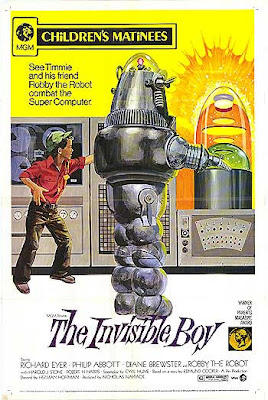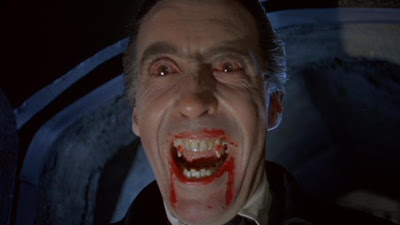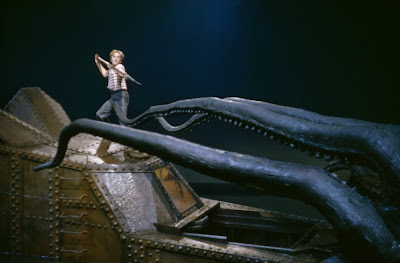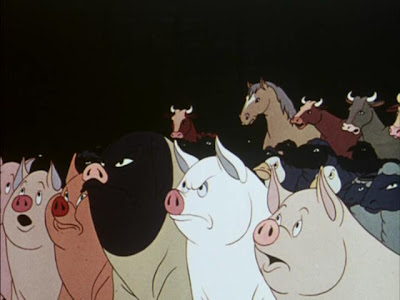Diabolique (aka: Les diaboliques) (1954) Don’t be
surprised if you experience a distinct sense of déjà vu while watching Diabolique (The French pun is purely
unintentional). From a modern
perspective it’s easy to dismiss all of the plot twists and turns as clichéd, instead
of seeing them as the inspiration for so many modern psychological thrillers
(including Hitchcock’s Psycho and the
under-seen Hammer film Taste of Fear). Director Henri-Georges Clouzot’s film is a
skillful combination of suspense and superb acting. The characters includes Christina Delasalle (played
by the director’s wife Vera Clouzot) and Nicole Horner (Simone Signoret) as
wife and mistress, respectively, to Michel Delassalle (Paul Meurisse), a cruel
boarding school principal. Both women
conspire to murder Michel and end his tyrannical cycle of physical and mental
abuse. There’s a stark contrast between
Christina, who grapples with her belief system, and Nicole, who lost her faith
a long time ago. Just when they think
they’ve pulled off the perfect crime, Michel’s body goes missing. Even if the shocks are not quite as jarring
as they must have been for audiences in 1954, the film maintains a high level
of tension throughout. Often imitated,
but never duplicated, Diabolique is a
true masterpiece.
Rating: **** ½.
Available on DVD
The Big Heat (1953)
Fritz Lang directed this film noir gem set in Los Angeles. Glenn Ford plays Dave Bannion, an honest cop investigating
the suicide of a fellow police sergeant.
He discovers that there’s more to the story than he originally thought, tracing
a cycle of corruption that leads all the way to the top, but his superiors just
want to sweep everything under the rug. Lang
depicts a city ruled by fear, where everyone keeps their mouth shut if they
want to live another day, and no one wants to lend a helping hand for fear of
reprisal. As Bannion gets closer to the
answers, his wife gets caught in the crossfire.
He becomes an unstoppable force, intent on finding the men responsible
for her death, and taking down the crimelord who’s pulling all of the strings
in town. In addition to Ford’s superb
portrayal of a copy who’s been pushed too far, there’s some great supporting
performances by Lee Marvin as the icy hired thug Vince Stone and Gloria Grahame
as his wise-cracking girlfriend Debby. It’s
a tense, gritty and taut crime drama that’s not to be missed!
Rating: **** ½. Available on DVD
Four-Sided Triangle (1953) Few probably remember this obscure Hammer science fiction film
from director Terence Fisher, but it’s worth a look if you’re a Hammer
completist or B sci-fi enthusiast. The title
refers to the relationship between two scientists and the woman that they love,
and the unusual solution that one of them concocts to solve their dilemma. Bill (Stephen Murray) is a brilliant inventor
who creates a device that can duplicate anything (Don’t hurt your brain trying
to figure out how such a device could actually work – his extremely cursory
explanation might as well involve magic).
When his childhood friend Lena (Barbara Payton) marries his mutual
friend and colleague Robin, he does what any other sensible researcher would
do, and creates a copy of Lena (referred to as Helen). Other than being easy on the eyes, I’m not
really sure what all the fuss was about with Lena, considering the fact that
she didn’t know who Albert Einstein (No, really!) was, perhaps proving that
love is dumb as well as blind. Filled
with unnecessary narration and a contrived ending that sidesteps the headier
moral and ethical dilemmas raised throughout, Four Sided Triangle could
have been better, but it’s still quite watchable.
Rating: ***. Available on DVD
Attack of the 50 Foot Woman (1958) Nancy Fowler Archer (Allison Hayes) is wealthy, alcoholic and
emotionally unstable. Her philandering
husband Harry Archer (William Hudson) plots to have her committed to a mental
hospital so he can take control of her fortune and run off with local town
floozy Honey Parker (Yvette Vickers). Probably
no one would remember the film today if not for the stroke of insanity/genius
on the part of the producers, who decided to add a cheesy sci-fi twist to this
little melodrama. Nancy encounters an alien
ship (which is repeatedly referred to as a “satellite”) with a bald 30-foot
alien lurking inside. Apparently, he
wants her expensive diamond necklace because his ship runs on diamonds (Um,
okay), but she manages to evade him.
It’s never really explained how or why she grows to such enormous
proportions (or why the alien was 30 feet tall, and she’s supposedly 50 feet). Attack
of the 50 Foot Woman is so bad, it’s nearly good, and taken in the right
light can be a heck of a lot of fun. It
has terrible effects (the alien, his spacecraft, and the title character are
all transparent), hammy acting and characters no one cares about. It’s hard to imagine that anyone ever thought
this movie was a good idea, but I’m sort of glad that they went ahead with it
anyway. Nathan Juran (who was apparently
so embarrassed by the material that he went by the name “Nathan Hertz” for this
film), coincidentally directed the superlative fantasy The 7thVoyage of Sinbad the same year!
Rating: ** ½. Available on DVD
The Manster (aka: The Split) (1959) This bizarre Japanese/American
co-production might be worth a look just for its sheer audacity. American reporter Larry Stanford (Peter
Dyneley) is having a great time in Japan, while his co-dependent wife pines for
him in the States. He’s investigating a
mad scientist (played by Tetsu Nakamura) who performs strange, poorly defined
experiments on humans. Larry soon
becomes the newest subject of his research after he’s injected with the latest
batch of serum. As the serum takes
effect he begins to sprout a new noggin, and serves as living evidence that two
heads are not necessarily better than one. While the film itself is goofy fun, it’s
hampered by a completely unsympathetic main character. Larry is such a selfish jerk to begin with,
that it’s hard to care what happens to him when he turns homicidal and begins
to go on a killing rampage through the streets of Tokyo. Because he doesn’t really seem to possess a
good half, the film becomes a Mr. Hyde and Mr. Hyde story. The
Manster is chock full of hammy acting, ridiculous dialogue and an ending so
abrupt that you’d swear they chopped off a complete scene (and with a scant 72
minute running time, it’s a distinct possibility). This isn’t a good movie by any stretch of the
imagination, but if you’re in the right mood (or possibly inebriated) this
could just be the ticket.
Rating: ** ½.
Available on DVD and Netflix Streaming
The Invisible Boy (1957) I regret to report that The Invisible Boy was not quite the lost
classic I was hoping for. With Robby the
Robot featured in a prominent role and a screenplay by Cyril Hume (who wrote
the screenplay for Forbidden Planet),
my level of expectations was set unrealistically high. While the film is sporadically amusing, it
eventually wears out its welcome due to an inconsistent tone and a meandering
story that seems to be cobbled together from other sci-fi movies. Richard Eyer stars as Timmie Merrinoe, providing
what I suppose is a “child’s eye” perspective of the world. His neglectful father (Philip Abbot) creates
a warehouse-sized supercomputer that runs off of punch cards (Ahh, modern
technology!), and fails to notice when his son successfully reassembles a robot
that was lying in pieces in his workshop.
Eventually, the computer becomes smarter, and takes control of Robby,
using the robot as an instrument to threaten the world. This odd shift in tone takes place about
two-thirds of the way in, as the film changes suddenly from whimsical to
serious. The stakes are raised as the
computer threatens to give the boy a slow, painful death (via Robby) if his
father doesn’t give in to its demands.
This isn’t exactly lightweight stuff, even if the movie itself is
supposed to be a slight “family” film.
The parents’ behavior is noticeably strange as well, as they appear to
be oblivious to Robby’s presence and mostly ignore Timmie. In one scene, the father is more interested in
doling out punishment than curious about how Timmy managed to become invisible. The
Invisible Boy is unavailable as a standalone disc, but can be found as an
extra (!) on the Forbidden Planet DVD
and Blu-ray. Come to think of it, you’re
probably better off just watching Forbidden
Planet instead.
Rating: **. Available
on DVD and Blu-ray (as an extra feature on the Forbidden Planet disc)
































